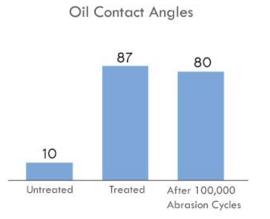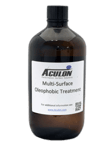Multi Surface Oleophobic Treatment
- General purpose hydrophobic/oleophobic treatment
- 30 - 300 nm thickness
- Reduces surface friction
Product Description
Aculon's Multi-Surface Oleophobic technology is designed to make many surfaces substrate hydrophobic, oleophobic, and repellent to nearly any liquid. Aculon's Multi-Surface Oleophobic treatment is quick and easy to apply, optically clear, and ultra-thin. For the application no capital investment is required, thus the treatment can be applied via several methods, including dip (30 nm), wipe (200-300 nm), or spray.
Advantages of Aculon's Multi-Surface Oleophobic Treatment
- Repels most liquids
- Optically clear (100% transmission)
- No capital equipment
- Easily reapplied in the field if damaged
Technical Specifications
| General Properties | |||||
| Color Color The color | Colorless | ||||
| Solids | 10 % | ||||
| Specific Gravity Specific Gravity Specific gravity (SG) is the ratio of the density of a substance to the density of a reference substance; equivalently, it is the ratio of the mass of a substance to the mass of a reference substance for the same given volume. For liquids, the reference substance is almost always water (1), while for gases, it is air (1.18) at room temperature. Specific gravity is unitless. | 1.12 | ||||
| |||||
| Thermal Properties | |||||
| Boiling Point Boiling Point The amount of degree’s needed to reach in order to make the substance boil. | 62 °C | ||||
| Flash Point Flash Point The flashpoint of a solvent is the lowest possible temperature at which it can vaporize to form an ignitable vapor. Flashpoint is often confused with “autoignition temperature”, which is the temperature at which a solvent ignites without an ignition source. | -10.5 °C | ||||
| Electrical Properties | |||||
| Visible Light Transmission | 100 % | ||||
| Other Properties | |||||
| Coating Thickness | 30-300 nm | ||||
Additional Information
| Test Substrate | Water Contact Angle/Oil Contact Angle |
| Treated 304 Stainless Steel | 115 °/61 ° |
| Treated Glass Slide | 115 °/60° |
| Treated Aluminum | 117°/59° |
| Sliding Angle of Water Droplet (20 ?L distilled water) | >90° |
| % Haze of Reflected Light | 0% |
How to apply Aculon's Multi Surface Hydrophobic Treatment
STEP 1 ⇨ CLEAN | STEP 2 ⇨ TREAT | STEP 3 ⇨ DRY |
For this technology, cleaning is not typically required but is recommended. To clean, remove any visual dust, dirt, and grime that could damage the surface. | Dip - Fully immerse the part in the treatment solution for 1 minute. Withdraw the part at a steady rate to ensure even coverage. Allow to dry or cure, then wipe clean with a microfiber cloth. |
Air dry at room temperature until the surface is dry to the touch. In some cases, additional thermal curing (e.g. 100°C for 5 minutes) may boost performance.
|
Wipe - Using a clean cotton cloth, wet it with the solution then rub the substrate for 10 seconds, air dry, then wipe clean with a microfiber cloth. | ||
Spray - Spray the solution on the substrate, air dry. If the coating is too thick, reduce the amount applied by changing the settings on the spray gun or using a diluent. |
Application Tips
- In some cases, additional thermal curing ( e.g. 100°C for 5 minutes) may boost performance.
- Inkjet printing or roll coating can also be used to apply the treatment.
- Spray Equipment Suggestions: HVLP(Binks Mach 1), HVLP(Devilbiss JGHV), Air Atomization(Devilbiss MBC gun), and Airless(Graco Model 225-292 President Pump Series A).
 | Improved function of microfluidic devices |
| Impart repellency to paper, wood, fabrics, concrete, etc. | |
| Improve water repellency on eyewear | |
| Improve water repellency on electronic displays |






